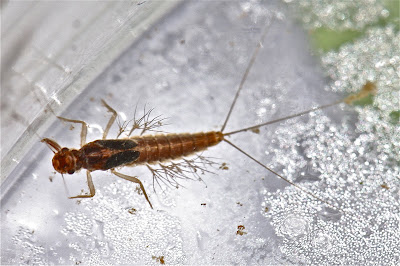Wednesday, June 8, 2011
The Rapidan at the Beginning of Summer: A New Mayfly Genus, Habrophlebia
The only one I saw today -- but it sure was a beauty! "Common stonefly," genus Paragnetina, and the Rapidan is the only place where I've ever seen this particular genus. A big one -- about 1 1/2 inches.
I found a new genus today -- a Pronggilled mayfly (family: Leptophlebiidae). But before I get to those photos, let me note all the insects I found, for which I will not show the photos I took. There were lots of netspinners today -- and they were big! I thought at first they were Macrostemum (the genus), but they turned out to be Hydropsyche. Spiny crawlers -- there are still some here (Ephemerella), but the numbers are down, and I also found a big genus Drunella. Lots of Perlodid stoneflies, Isoperla holochlora -- it may have been the dominant taxon today -- and I also found one genus Remenus. There were quite a few young, small, stoneflies, both Giants and Perlids (genus Acroneuria). And I found a fair number of very large Brushlegged mayflies, very dark in color, I'd guess that they're ready to hatch. (These are probably Isonychia bicolor -- the "Slate Drake" to fly fishermen -- and a friend of mine recently sent me a photo of an adult she had seen in streamside bushes.) One quick photo of the front end of one of those nymphs since it really shows the "brushed legs".
Finally, I saw a few flatheaded mayflies, genus Epeorus and genus Leucrocuta.
Now, for the "catch of the day."
I suspected that this was a Pronggilled mayfly -- and I was right -- but I had never seen any gills like that before. The genus is Habrophlebia, on which Peckarsky says the following: "Each gill on abdominal segments 2-6 consists of 2 clusters of filaments." (Freshwater Macroinvertebrates, p. 31). Here's a better look at those gills.
Pretty cool. Remember that the "common" Pronggilled we see around here is genus Paraleptophlebia, which has simple forked gills, as in the photo below (click on the picture to enlarge). This Pronggilled was found in the same river on February 23rd.
Two final comments: 1) note that the Habrophlebia nymph is fully mature (long, black wing pads), and it's small -- quite a bit smaller than the Paraleptophlebia nymphs that I'm used to seeing. And 2) for the fly fishermen -- I don't think this is a significant insect for us: Habrophlebia is not even mentioned in Knopp and Cormier, Mayflies: An Angler's Study of Trout Water Ephemeroptera.
Another treasure today -- another Limnephilid (Northern case-maker) caddisfly larva, and I've not seen this case construction before: small chips of wood and sand forming the center, twigs along either side -- sort of looks like a hot dog in a bun that's covered with chile!
(Note the spiny crawler hitching a ride in the bottom photo!) I examined this larva at home to determine the genus, and it looks to me like another Pycnopsyche (for the key features of that genus, see the entry for 5/7). I'm not 100% sure of that conclusion: the "SA1" metanotal sclerites are clearly not fused, but the lateral humps have collapsed, so it's difficult to see the sclerite along the back edge.
Two other things worth noting. First, I found a number of small, small minnow mayflies, and I found two different genera: Acentrella and Heterocloeon. The Heterocloeon nymph was mature and ready to hatch (black wing pads); the Acentrella nymphs were very young -- tiny, short wing pads. I know that we see a lot of Acentrella nymphs at a number of streams in the fall. So it's starting to look to me as though the small minnows we find in our streams are: genus Baetis in the winter; Heterocloeon (not in large numbers) in the spring; and Acentrella in late summer and fall. Obviously this is an hypothesis that has to be tested.
Second, I found a couple of fingernet caddisfly larvae, and in this stream the genus we find is Dolophilodes (vs. the more common Chimarra).
Not the best of photos, but I just couldn't get this larva to pose! I hope you recall from previous entries that Chimarra fingernets have a deeply notched "frontoclypeal apotome" (leading edge of the head), while the Dolophilodes edge is simply asymmetrical. Take a look.
(Below: the Rapidan River where it emerges from the Shenandoah National Park.)
Subscribe to:
Post Comments (Atom)











No comments:
Post a Comment